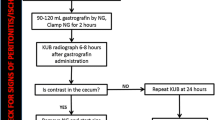Abstract
Capsule endoscopy (CE) has been demonstrated to be safe and well tolerated in adults with suspicion of small intestinal diseases with negative results of gastroscopy and colonoscopy. However, its value in pediatric patients has not yet been well studied. This study aimed to evaluate the results and safety of CE in pediatric patients with suspicion of small bowel disorders. There were 16 consecutive children and adolescents (12 boys, 4 girls) and 15 adults (9 men, 6 women) referred to us for suspected small bowel diseases from August 2002 to September 2005. Among the pediatrics, six patients were less than 10 years old. Technique for capsule placement, gastric transit time, small bowel transit time, excretion time of capsule endoscopy, capsule findings, and complications were recorded. All 16 pediatric patients described that the capsule was easy to swallow except for three children. Finally we delivered the capsule under gastroscopy with overtube for these three children. No capsule retention occurred during our study. Median recording time was 7 h 44 min (range 6 h 51 min–9 h 11 min). Median gastric transit time was 83.5 min (range 4–296 min). Median small bowel transit time was 270 min (range 142–484 min).Median excretion time of capsule was 33.9 h (range 12–96 h). There was no significant difference in excretion time of capsule, gastric transit time and small bowel transit time between pediatric patients and adult patients (P > 0.05). CE was positive in 12 patients, including Crohn’s disease (4), hemangioma (2), angiodysplasia (2), Meckel diverticulum (1), polyp (1), aphthous ulcer in ascending colon (1), and cobblestone appearance of ileal mucosa. CE has been performed safely in a small series of pediatric patients after ingestion or endoscopic placement of the capsule. The high yield of abnormal findings was comparable to those of adult patients.


Similar content being viewed by others
Abbreviations
- CE:
-
capsule endoscopy
References
Appleyard M, Glukhovsky A, Swain P (2001) Wireless-capsule diagnostic endoscopy for recurrent small bowel bleeding. N Engl J Med 344:232–233
Aabakken L, Scholz T, Ostensen A, Emblem R, Jermstad T (2003) Capsule endoscopy is feasible in small children. Endoscopy 35:798
Barth BA, Donovan K, Fox VL (2004) Endoscopic placement of the capsule endoscope in children. Gastrointest Endosc 60:818–821
Balba NH, Chutkan RK (2002) Measurement of gastric and small intestine transit time using the video capsule endoscope. Gastrointest Endosc 55:AB136
Barkin J, Friedman S (2002) Wireless capsule endoscopy requiring surgical intervention: the world’s experience. Am J Gastroenterol 97:S298
Carey EJ, Heigh RI, Fleischer DE (2004) Endoscopic capsule endoscope delivery for patients with dysphagia, anatomical abnormalities, or gastroparesis. Gastrointest Endosc 59:423–426
Faigel DO, Fennerty MB (2002) “Cutting the cord” for capsule endoscopy. Gastroenterology 123:1385–1397
Fleischer DE (2002) Capsule endoscopy: the voyage is fantastic: will it change what we do? Gastrointest Endosc 56:452–456
Furman M, Mylonaki M, Fritscher-Ravens A, Swain P, Heuschkel R, Murch S (2003) Wireless capsule endoscopy in children: a study to assess the diagnostic yield in small bowel disease in pediatric patients. Gastrointest Endosc 57:AB89
Gong F, Swain P, Mills T (2000) Wireless endoscopy. Gastrointest Endosc 51:725–729
Ge ZZ, Hu YB, Xiao SD (2004) Capsule endoscopy and push enteroscopy in the diagnosis of obscure gastrointestinal bleeding. Chin Med J 117:1045–1049
Ge ZZ, Hu YB, Xiao SD (2004) Capsule endoscopy in diagnosis of small bowel Crohn’s disease. World J Gastroenterol 10:1349–1352
Ge Z-Z, Hu Y-B, Gao Y-J, Xiao S-D (2003) Clinical application of capsule endoscopy. Chin J Dig 23:7–10
Hollerbach S, Kraus K, Willert J, Schulmann K, Schmiegel W (2003) Endoscopically assisted video capsule endoscopy of the small bowel in patients with functional gastric outlet obstruction. Endoscopy 35:226–229
Iddan G, Meron G, Glukhovsky A, Swain P (2000) Wireless capsule endoscopy. Nature 25:405–417
Lewis BS, Swain P (2002) Capsule endoscopy in the evaluation of patients with suspected small intestinal bleeding: results of a pilot study. Gastrointest Endosc 56:349–353
Sultan S, Dobozi B, Palmer P, Treem W, Agrawal N (2003) Assisted wireless capsule endoscopy in a six-year-old with abdominal pain and obscure GI bleeding. Gastrointest Endosc 57:AB127
Sant’Anna AMG, Dubois J, Miron MC, Seidman EC (2005) Wireless capsule endoscopy for obscure small-bowel disorders: final results of the first pediatric controlled trial. Clin Gastroenterol Hepatol 3:264–270
Stiffler H (2003) Capsule endoscopy: a case study of an 11-year-old girl. Gastroenterol Nurs 26:38–40
Sant’Anna A, Seidman E (2003) Wireless capsule endoscopy: comparison study in pediatric and adult patients. J Pediatr Gastroenterol Nutr 37:332
Author information
Authors and Affiliations
Corresponding author
Additional information
Supported by Shanghai Leading Academic Discipline Project (Project number: Y0205).
Rights and permissions
About this article
Cite this article
Ge, ZZ., Chen, HY., Gao, YJ. et al. Clinical application of wireless capsule endoscopy in pediatric patients for suspected small bowel diseases. Eur J Pediatr 166, 825–829 (2007). https://doi.org/10.1007/s00431-006-0331-9
Received:
Accepted:
Published:
Issue Date:
DOI: https://doi.org/10.1007/s00431-006-0331-9




